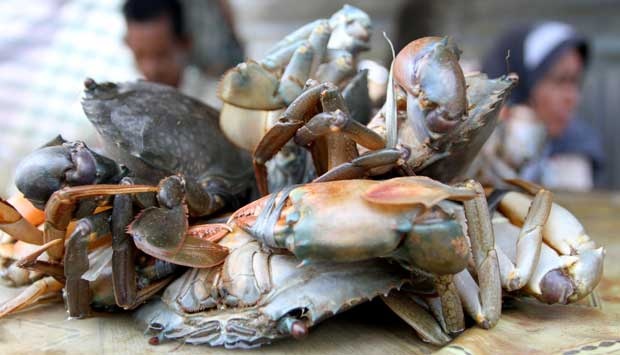Mud crab (Scylla serrata) is one of the largest portunids living on the coast and mangrove swamps and vast distributed throughout the Indo Pacific coastal region. They associate with mangrove and also tolerate reduced salinity. This crab has high economic and nutritional value and marketed in various forms of production, such as live crab, soft shell crabs, crab meat, crab paste, crab cakes, crab claws and crab waste that can be processed into various raw materials of the pharmaceutical industry, fisheries. Hence there is a lot of demand and high prices in domestic and international markets.
In Indonesia, due to its delicacy and greater size, larger market demand and higher prices, resulting in a vast development in the mud crab S. serrata commerce with more enormous scope in the domestic market, such as in Kalimantan, Sulawesi, Java, Sumatra, Papua, West Papua and as well as in Japan, Hong Kong, South Korea, Taiwan, Singapore, Malaysia, Australia and France. Southeast Asian fishers have been cultivating mud crabs for a long time, which were based on young crabs taken from capturing in nature, and fattened by operating culture in an existing pond or pen, a tidal river or creek. Moreover, the culture of crabs in ponds shows some disadvantages, such as: requiring large area, exposure to pollution from open waters, high penetration of sunlight to crabs, cannibalism, crabs escaped from ponds still high, burrowing habit causing difficult harvest, low security, and wasteful energy.
Several commercial cultures of mud crabs have been carried out, but low survival has become a significant obstacle for commercial operations. The primary cause of mortality in S. serrata due to they are maintained in communal rearing ponds or tanks. In crab culture with the communal rearing ponds method, intraspecific predation is an essential source of mortality, such as Macrobrachium rosembergii, Homarus americanus, Cancer master, Cancer pagurus, Porcellana platycheles and Paralithodes camtschaticus. Hence, cannibalism is one of the main reasons for failures in the development of culturing methods for a variety of crab species. By maintaining mud crabs in individual containers, the survival of mud crabs can be dramatically improved compared to crabs which are maintained in ponds where cannibalism is prevalent.
The improvement or innovation of the crab culture system through the crab farming technology in battery boxes immersed in the pond still shows some weaknesses, such as high mortality rate, decreased water quality due to significant remnant food and exposed to pollution from open waters, crab exposed by direct sunlight resulting in high mortality, bad water recirculation system, low land efficiency, low-security level, and low work comfort. Then, there is necessary to introduce an advanced system in crab culture by operating the flow or recirculation of land-based cultivation facilities (Shelley and Lovatelli, 2011). The crab bucket recirculating water aquaculture system is an advanced system which provides individually aquaculture cage for each crab to avoid the crabs between the mutual killing.
The system is equipped with a recirculating water system passing a water filter to purify and increase oxygen into water media. This aquaculture recirculation systems are a necessary tool to provide sustainable and continuous aquaculture production with low environmental impact. This system can automatically discharge feces and remnant food to maintain a good quality water environment in each bucket. This aquaculture system is very useful in supporting the development of crab aquaculture and has a positive impact on improving marine agro-industry, especially mud crab aquaculture in Indonesia.
This study aimed to determine the survivability and growth of mangrove crabs which cultivated in the crab bucket recirculating aquaculture system. The result of the research is expected to be new information on a more efficient, ecological, household scale crab cultivation system which can solve the problem of traditional crab cultivation. Research activities were conducted in the aquaculture laboratory at LPWP (Coastal Area Development Laboratory) Diponegoro University, Jepara, Indonesia. The experimental animal used was mud crabs (S. serrata) with the weight from 73 to 87 g. Each crab placed separately in individual crab buckets, where 1 bucket contained 1 individual crab. The crab buckets used were made from plastic material with a diameter and height of 22 x 25 cm respectively, and installed with the recirculating aquaculture system.
Two types of culture cages system were applied as a treatment. First, open cages (without bucket lid) were classified in group A; and second, closed cages (with lid bucket) were classified in Group B. Parameter observation was done on the survivability and growth of mud crab. The water quality of culture media was measured and analyzed as a supporting factor. The data were analyzed using variance analysis (ANOVA). The result of the research showed that the survivability of mud crab was between 63 to 79% during 48 days of culture. Absolute growth was between 33 to 76 g (or 0.68 to 1.58 g day1 ) after the culture period. The specific growth rate of mud crab ranged from 0.67 to 1.36% day-1. Water quality parameters of culture media by using the recirculating water system were still within the proper range for the life of mud crab. It is concluded that the application of the crab bucket recirculating aquaculture system can give the expectation for the development of mud crab culture in the future.
Author: Agoes Soegianto
Detail writing about this research can be seen at
https://www.researchgate.net/publication/335517956_Survival_and_Growth_of_mud_crab_Scylla_serrata_Forsskal_1775_reared_in_crab_bucket_recirculating_aquaculture_system Bambang Yulianto, Sunaryo, Nur Taufiq S.P.J., Ali Djunaedi, Subagiyo, Adi Santosa dan Agoes Soegianto. 2019. Survival and Growth of mud crab (Scylla serrata Forsskål, 1775) reared in crab bucket recirculating aquaculture system. Ecology, Environment and Conservation Paper (EM Interbational), Vol 25, July Suppl. Issue, 2019; Page No.(S119-S128)





